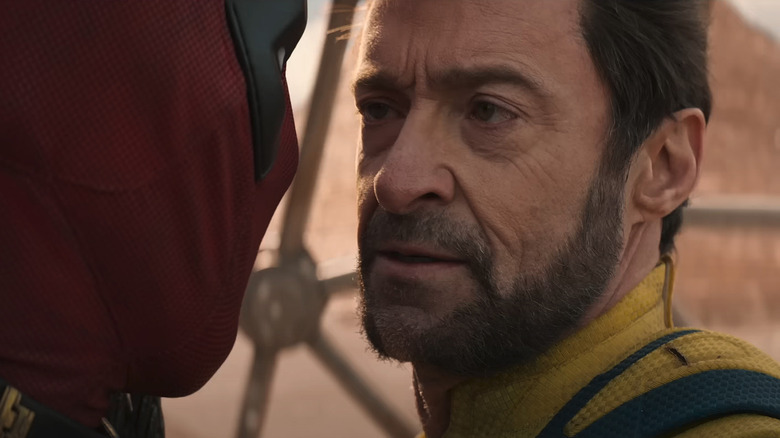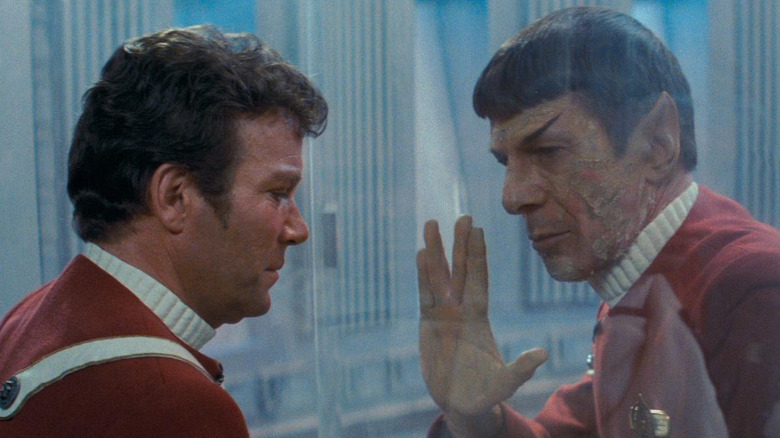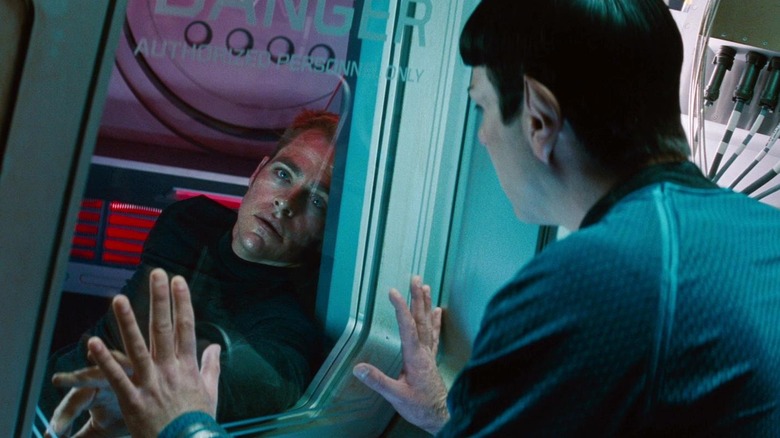Deadpool & Wolverine's Very Specific Star Trek Joke, Explained For Non-Trekkies
Warning: this article contains spoilers for the end of "Deadpool & Wolverine."
At the end of Shawn Levy's "Deadpool & Wolverine," the 34th film in the ever-shambling Marvel Cinematic Universe, the two title characters (Ryan Reynolds and Hugh Jackman) must stop a wicked villain named Cassandra Nova (Emma Corrin) from activating a doomsday device called a Time Ripper that can erase entire parallel universes. Deadpool, while often flippant and irreverent, doesn't want to see his best friends killed, and he decides to do the noble thing by destroying the machine and saving his universe.
To do so, however, he has to use his usually indestructible body to complete a current between two of the Time Ripper's live wires. The explosion will vaporize him and actually kill him, something that bullets and knives have, as yet, been unable to do. The Wolverine in this movie, incidentally, isn't the same one audiences saw in the previous nine X-Men films, but a new parallel version culled from a universe of his own. This Wolverine is a sad sack, carrying an albatross of shame around his neck after letting down his entire timeline and taking a dark, violent turn. Shamed, he feels he can redeem himself by sacrificing his own life and destroying the Time Ripper.
Deadpool, however, out-nobles Wolverine and locks him outside the Time Ripper control room. Deadpool peers through a glass portal, apologizing for doing his act of nobility alone as only the Merc with a Mouth can. He puts his hand on the glass and comments that he is also Spock "or perhaps Kirk," and even spreads his fingers into the famous Vulcan salute so often seen on "Star Trek."
For those completely unfamiliar with "Star Trek," this is a moment cribbed from "Star Trek II: The Wrath of Khan," as well as "Star Trek Into Darkness."
Deadpool takes Spock's noble death
Nicholas Meyer's 1982 feature film "Star Trek II: The Wrath of Khan" ends with a submarine-like battle, wherein the U.S.S. Enterprise goes head-to-head with the U.S.S. Reliant, a starship hijacked by the vengeance-bent Khan (Ricardo Montalbán). Both ships get in a few choice shots, leaving each of them crippled in space. Indeed, the Enterprise begins to malfunction, and a vital component of its engine needs to be repaired in a hurry if it's to survive. Spock (Leonard Nimoy) enters a heavily irradiated chamber to fix said component, exposing himself to a lethal dose of radiation.
Once the peril is over, Admiral Kirk (William Shatner) races to the main engineering, just to see Spock slowly perish from radiation burns. They are able to have a brief, touching conversation through a pane of glass as the two old friends bid one another farewell. Spock's final words are, "Live long and prosper," and he places his Vulcan salute on the pane. It's a wonderfully sad ending to what is often considered to be the best "Star Trek" movie.
"Deadpool," very keen to work pop culture references into most of his conversations, was merely repeating that moment, highlighting that he knew he was going to die. He's flippant about his death, of course, and even briefly does some mock Superman flying and a bit of "walking downstairs" mime to take the edge off. The ending of "Deadpool & Wolverine" isn't as moving as "Star Trek II: The Wrath of Khan," but it at least recognized that it was doing something similar.
But that's not quite where the references end. Indeed, the movie is also riffing on "Star Trek Into Darkness," which was also already riffing on "Star Trek II." The snake begins to eat its own tail.
Star Trek Into Darkness flipped death scene
In 2009, many might recall that J.J. Abrams rebooted the "Star Trek" universe, using a parallel timeline to re-tell the origins of Kirk (Chris Pine), Spock (Zachary Quinto), and other Enterprise crew member. This was a high-octane, action-forward version of "Star Trek" that used the original show's characters and iconography, but none of its slow pace or intellectual analysis. The second film in the rebooted series was called "Star Trek Into Darkness," and it, too, was about Khan, now played by Benedict Cumberbatch. "Into Darkness" also involved a ship-to-ship battle at its conclusion, wherein the U.S.S. Enterprise was similarly damaged the way it was in "Star Trek II."
This time, however, it was Kirk who entered the irradiated chamber to fix the broken engine component, and it was Kirk who received a lethal dose of radiation. In a quote from "Wrath of Khan," Kirk and Spock also bit each other farewell through a pane of glass.
So when Deadpool said that he may be Kirk or Spock, he was playfully referring to the way "Star Trek" had the same climax in two of its films, just with the characters inverted. Luckily, Spock is resurrected in "Star Trek III: The Search for Spock" through a combination of life-giving radiation and an oblique consciousness-shunting ritual. And Kirk is resurrected using a vial of Khan's specially enhanced blood, powerful enough to bring him back from the dead. Just like in superhero movies, no one really dies.
"Deadpool & Wolverine" is now playing in theaters everywhere.


